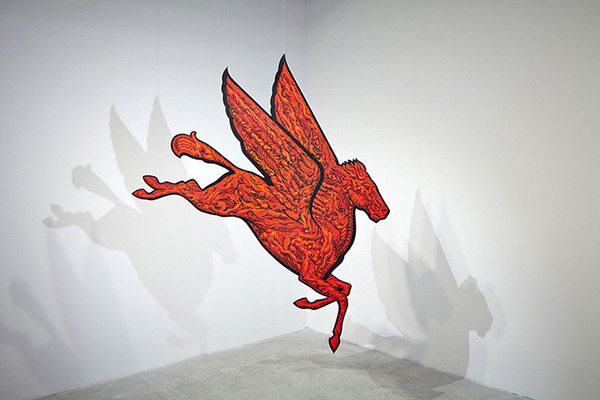From the Redwood forest to the Gulf Stream waters, Mark Dean Veca’s exhibition, “Made for You and Me,” echoes the fractured reality of the American Dream. Using his signature pop culture cartoon references, Veca’s work blends a sense of canned happiness with the grotesque, creating pieces that seem in flagrant contention with themselves. Begun in 2009 amidst the climate of a global recession, this body of work employs the symbols of capitalism that had been used to celebrate American success in a perverse way. Here Veca's paintings on wood and canvas illustrate the harsh reality of a fall from grace. There is a growing tradition of artists appropriating characters from advertisements and cartoons to raise questions about popular culture. Mickey Mouse, Popeye and Rich Uncle Pennybags (also known as the Monopoly man) are a typical selection of illustrators and fine artists. Veca uses these familiar figures too but what sets his work apart is the treatment he gives them.
From afar, the smiling faces are jolly and welcoming, but Veca’s works are meant to be observed at a close distance; here one gets to the root of his inspiration. Each of the iconic faces and logos are comprised of intricate patterns, modernized versions of Toile de Jouy. Toile was often used by the upper class of the mid-18th century to depict the bucolic and pastoral scenes of country dwellers. Veca’s appropriation of this technique references an antiquated upper class perspective that he identifies amongst the big oil and capitalist barons of today. Yet his modernized Toile de Jouy is not made up of delicate strokes, instead sinuous twists and turns take on a sinister feel, oozing in emulation of the oil that is used to run the world.

Mark Dean Veca, Blue Dollar Sign, 2010; Courtesy of the Artist and the Cristin Tierney Gallery, NY.
Every face, dollar sign and star spangled pattern is made up of intestinal globs and dripping guts. In other works viscera coagulates into the Exxon Pegasus and Reddy Kilowatt. Instead of the logos and characters booming with life, power and success, they are weighed down, seeping with contention and an insatiable lust for consumption.
These dualities feel as relevant to the recession mentality as they do the long awaited recognition of climate change as a bonafide issue by the American government. They resonate with the urgency to turn away from big oil and fossil fuel consumption, and to transfer our power-hungry needs toward renewable and clean resources.

Mark Dean Veca, Tailspin (Mobil Mobile), 2012, India ink and acrylic on shaped PVC panel, motor, 69.5 x 58.5 x 0.25 in.; Courtesy of the Artist and the Cristin Tierney Gallery, NY; © John Muggenborg, 2013.
Witnessing the turn of glorified capitalistic symbols into emblems of greed and disgust, the viewer's only way to rectify the transformation is with acceptance. Although Veca portrays capitalism and nationalism in a maniacal light, his decision to keep these characters in their original strong, bold and colorful state suggests a kind of confidence or perhaps an iconic resilience. Is it possible that the irony may just morph into the next best thing?
(Image on top: Mark Dean Veca, Reddy, 2012, India ink and acrylic on canvas , 32 x 48 inches; Courtesy of the artist & Cristin Tierney Gallery.)